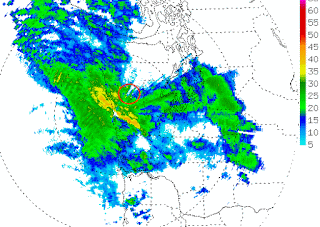There is nothing I like better than a meteorological mystery ...particularly one that is not easily solved.
And here is a recent one, which I am working on now...a massive tree fall on the north side of Lake Quinault on the SW flanks of the Olympic Peninsula (see map) that took place on Saturday, January 27th just after midnight.
The center of the action was around the July Creek campground on the north side of the Lake (see close-in map), where hundreds of massive, old-growth trees were snapped off. And there were lesser tree falls on the southern side of the lake, all of which caused the loss of power in the area.
Here are few pictures around the North Shore road, on the northern flank of the Lake. Pictures courtesy of Bill Baccus, Olympic National Park. Some of the trees were huge.
And here is a video from Grays Harbor PUD
Why did this event happen? Some, such as a story in the Daily World (see below), suggests\ that the event was the result of a microburst, a downward push of air out of a convective system that produces very strong winds in a limited area.
But I suspect the true explanation is different...
First, how strong did the winds have to be to do such damage? I spoke to Logan Johnson, Meteorologist in Charge, at the NWS Seattle Office. He suggested that to snap off such big trees would take winds of at least 70-80 mph. Maybe more.
Many of the big tree falls on the north side of the Lake were limited to a roughly 1/2 stretch of the North Shore Road near the July Creek campground (see map above). But there were some scattered tree falls elsewhere, such as on the south side of the lake.
Most of the trees on the north side fell towards the lake (to the south), which suggests the super-strong winds there were northerlies (from the north).
Isn't this fun? Just like Sherlock Holmes---pulling the clues together.
A big clue: the timing. According to the folks at Olympic National Park and Grays Harbor PUD, the big tree fall occurred between 1:30 and 2:30 AM on January 27th.
What could cause winds that would produce limited tree falls in a broad area and catastrophic winds in a small one? The Daily World and some folks at Olympic National Park suggest a microburst.
The definition of a microburst is:
A microburst is a localized column of sinking air (downdraft) within a thunderstorm and is usually less than or equal to 2.5 miles in diameter. Microbursts can cause extensive damage at the surface, and in some instances, can be life-threatening.
They are associated with thunderstorms and strong convection. Such storms have a characteristic look on weather radar...and we have good radar coverage in the area thanks to the Langley Hill Radar and Senator Maria Cantwell, who got the funding for it. Here is a radar image at 1:30 AM that day, with a circle indicating the region of interest. No hint of instability and thunderstorms.
And you would not expect it since a warm or occluded front was moving in.
OK... so it wasn't a microburst. What else could it be? My attempt at an answer will wait until Part II of this blog. But keep this Holmes' quote in mind:
Those willing to guess, please feel free to leave your ideas in the comment section of this blog....

















0 Comments